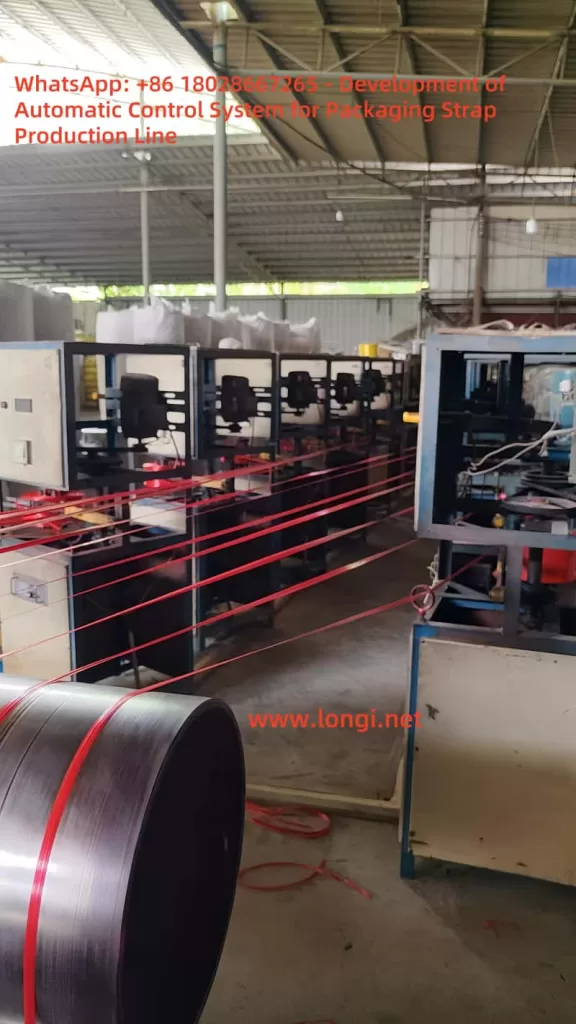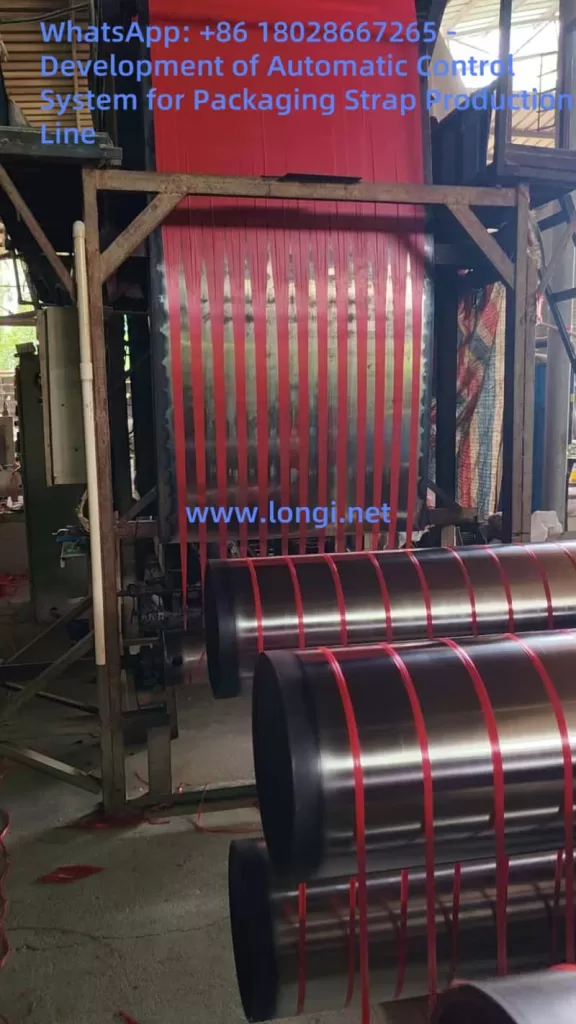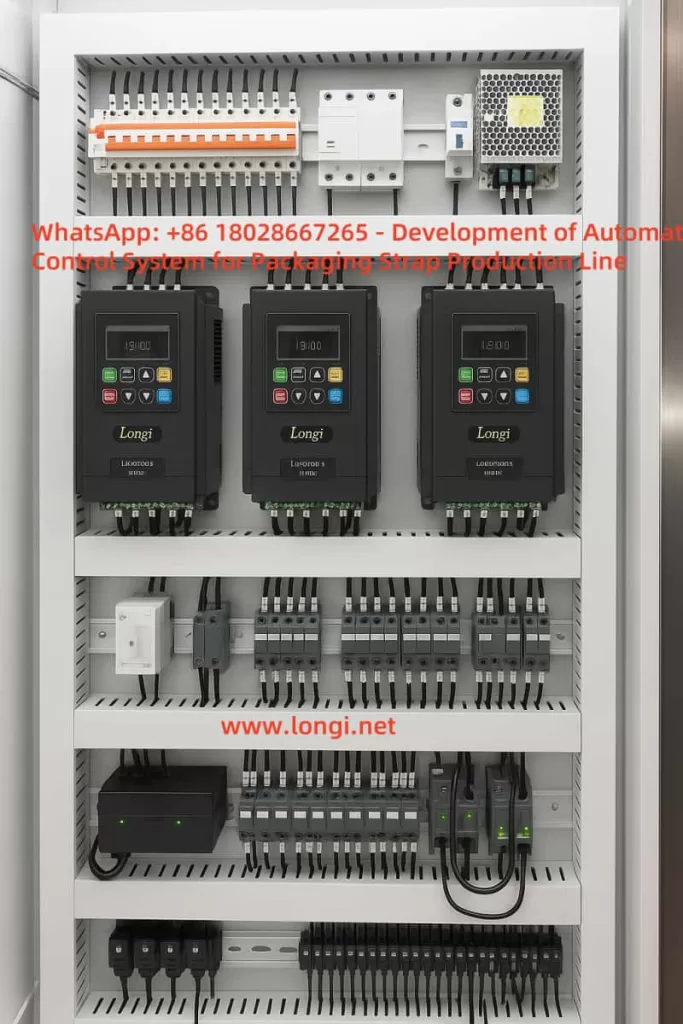1. Overview and Requirements of the Packaging Rope Production Line
The packaging rope production line is widely used for processing polypropylene (PP) and polyethylene (PE) materials. It primarily involves extrusion, stretching, twisting, and winding to produce the required packaging ropes. The production line involves several motors, heating control, tension control, and synchronization control. The stability and precision of the equipment are critical for production efficiency and product quality.
Main Equipment:
- Extruder: Used for melting and extruding the raw material into a uniform melt.
- Drawing Machine: Used for stretching the cooled fibers to increase strength and elasticity.
- Twisting Machine: Used for twisting the stretched fibers into ropes.
- Winding Machine: Used for winding the finished ropes into coils.

2. Control System Design
1. Motor Control and Inverter Selection
Motor control is essential for precise production on the line. The speed of each device’s motor must be adjusted in real-time to meet the production process’s requirements. Longi 9000 series inverters will be used to control the speed of each motor.
Extruder Motor Control:
- Motor Power: Typically, 15-55 kW asynchronous motors are selected.
- Inverter Model: Longi 9000 series inverters are suitable for high-power motors, providing precise speed control.
- Wiring Method: The inverter’s input is connected to a three-phase power supply, and the output is connected to the motor terminals via cables, usually using a star connection for stable starting torque and reliability.
Extruder Motor Parameter Settings:
- Frequency Range: 0-60Hz (can be adjusted depending on production requirements, typically set at 30Hz).
- Acceleration/Deceleration Time: Set to 5-10 seconds for smooth starting and stopping, avoiding overload.
- Current Limiting: Set to 120% of rated motor current as protection.
Drawing Machine Motor Control:
The drawing machine is used to stretch the fibers, and its speed is directly linked to the extruder’s output speed. The drawing machine inverter will be synchronized with the extruder inverter.
- Motor Power: Typically, 5-15 kW asynchronous motors are selected.
- Inverter Model: Longi 9000 series inverters.
- Wiring Method: Similar to the extruder inverter, connected via bus for synchronized control.
Drawing Machine Motor Parameter Settings:
- Frequency Range: 0-100Hz to match stretching speed with the extruder.
- Acceleration/Deceleration Time: Set to 5-10 seconds to avoid fiber breakage from fast stretching.
- Speed Synchronization: Use the inverter’s multi-machine synchronization function to keep the drawing machine synchronized with the extruder.
Twisting Machine and Winding Machine Motor Control:
Both the twisting machine and winding machine require precise speed control, especially for tension control under different conditions.
- Motor Power: Twisting machine typically uses 2-5 kW motors, and winding machine uses 5-15 kW motors.
- Inverter Model: Longi 9000 series for precise speed regulation and starting/stopping control.
- Wiring Method: Standard three-phase connection, with the inverter connected to the motor.
Twisting Machine Motor Parameter Settings:
- Frequency Range: 0-60Hz.
- Acceleration/Deceleration Time: Set to 3 seconds for smooth twisting.
- Synchronization Function: Achieved through PLC coordination with the drawing and winding machines.
Winding Machine Motor Parameter Settings:
- Frequency Range: 0-60Hz, closely related to fiber tension.
- Acceleration/Deceleration Time: Set to 5 seconds for uniform winding.

2. Heating Control System and Temperature Regulation
The heating system in the extruder is crucial for maintaining material quality. Temperature control must be precise. We will use Longi PLC (LX1000 series) along with temperature control modules to monitor and adjust the temperature.
Extruder Temperature Control Design:
- Heating Zones: The extruder has multiple heating zones, each equipped with a temperature control module to monitor and adjust the temperature.
- Wiring Method: The temperature control module’s output is connected to the heater, and the PLC adjusts the temperature using analog outputs (4-20mA).
- Temperature Sensor: Use PT100 sensors with an accuracy of ±0.5°C to provide real-time temperature feedback to the PLC.
Temperature Control Parameter Settings:
- Set Temperature Range: Typically set at 180-220°C for different zones, suitable for PP and PE melting temperatures.
- Temperature Adjustment Strategy: Use PLC’s PID control algorithm to maintain precise temperature, avoiding overheating or cooling, which may cause instability in the material quality.
3. Tension Control System
Precise tension control is essential during the drawing and winding processes to prevent fiber breakage or uneven winding. We will integrate tension sensors with the Longi PLC to implement real-time tension monitoring and control.
Tension Control Design:
- Tension Sensors: Select high-precision tension sensors like the FMS series, installed at key points on the drawing and winding machines for real-time feedback.
- Control Method: The PLC receives signals from the tension sensors and adjusts the drawing and winding speeds to maintain consistent tension.
- Wiring Method: The tension sensors provide analog signals to the PLC, which adjusts the motor speeds for closed-loop tension control.
Tension Control Parameter Settings:
- Target Tension Range: Set between 0.5-2kg to ensure stable fiber stretching and winding.
- Feedback Method: PLC adjusts the drawing and winding machine speeds based on the tension feedback from sensors.
4. Synchronization Control Scheme
Synchronization control between multiple devices is essential for smooth production. We will use Longi PLC’s high-speed counters and pulse output features to synchronize devices.
Synchronization Control Design:
- Master and Slave Synchronization: The extruder will be the master device, while the drawing machine, twisting machine, and winding machine will be slaves. The PLC will synchronize these machines via pulse output.
- Wiring Method: The PLC sends pulse signals to all devices using high-speed counters to synchronize their operation.
- Synchronization Adjustment: The PLC adjusts each device’s speed according to the main device’s status, ensuring coordinated operation.
Synchronization Control Parameter Settings:
- Synchronization Pulse Frequency: Set to 50Hz to synchronize all devices.
- Precision Requirements: The PLC’s pulse output precision is set to 1ms to ensure synchronization accuracy.

3. System Architecture and Wiring Diagram
Below is the basic wiring and architecture diagram for the packaging rope production line control system:
Equipment Connection and Wiring Diagram:
[Raw Material Mixer] → [Extruder] → [Cooling Tank] → [Drawing Machine] → [Twisting Machine] → [Winding Machine]
↑ ↑ ↑ ↑
| | | |
[Longi PLC] ←→ [Longi 9000 Inverter] ←→ [Temperature Control Module] ←→ [Tension Sensors]
System Architecture Diagram:
+------------+ +-------------+
| Longi PLC | ←--> [Inverter] ←--> [Motor] ←--> [Device]
+------------+ +-------------+
↑ ↑
[Sensors] ←--> [Tension Control] ←--> [Heating Control]
4. Conclusion
By integrating Longi 9000 series inverters, LX1000 series PLCs, and Longi plastic machine configuration software into the packaging rope production line, we can achieve precise motor control, temperature regulation, tension control, and synchronization control, ensuring efficient and stable production. The design is clear and logically sound, meeting the needs of modern packaging rope production lines for automation and intelligence.
